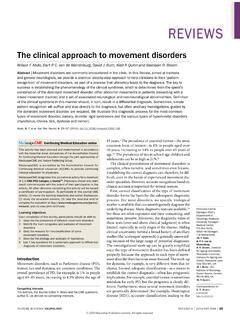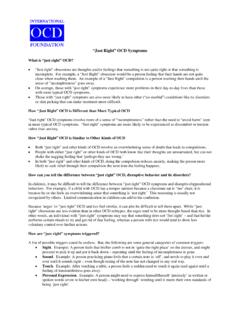Transcription of MANAGING TOURETTE & TIC DISORDERS
1 MANAGING TOURETTE & TIC DISORDERS A Guide to Treatment for Care Providers42-40 Bell Blvd., Suite 205, Bayside, NY 11361 888-4 TOURETD iagnosing and Treating TOURETTE Syndrome & Tic DisordersPROVIDING AN ACCURATE DIAGNOSISTics are involuntary, repetitive movements and vocalizations. They are the defining feature of a spectrum of childhood-onset, neurodevelopmental conditions known collectively as Tic DISORDERS and individually as TOURETTE Syndrome (TS), Persistent (Chronic) Motor or Vocal Tic Disorder, and Provisional Tic Disorder. These three Tic DISORDERS are distinguished by the types of tics present (motor, vocal/phonic, or both) and by the length of time that they are present. Below are the criteria that are used for identification and differential diagnostic A diagnosis is made by a physician or other health care professional based on the history of symptoms.
2 There is no biological test to confirm the diagnosis of TS, but in some cases, tests may be necessary to rule out other Syndrome (TS), also referred to as TOURETTE s Disorder1) Both multiple motor and 1 or more vocal tics have been present at some time during the disorder, although not necessarily concurrently. 2) Tics may wax and wane in frequency but have persisted for more than 1 year since first tic ) Onset is before age 18 years. 4) The disturbance is not attributable to the physiological effects of a substance or another medical conditionPersistent (Chronic) Motor or Vocal Tic DISORDERS Single or multiple motor OR vocal tics have been present, but not both. Provisional Tic DISORDERS Single or multiple motor and/or vocal tics. Tics have been present for less than 1 year, and criteria have not been met for TS or persistent (chronic) motor or vocal tic Bell Blvd.
3 , Suite 205, Bayside, NY 11361 888-4 TOURET1 Criteria are modified from the American Psychiatric Association: Diagnostic and Statistical Manual of Mental DISORDERS , 5th edition. Arlington, VA., American Psychiatric Association, OF TICSOTHER IMPORTANT CHARACTERISTICS OF TICS They can change in type, intensity, and location. They often increase with stress, excitement, anxiety, and fatigue. Some may be suppressed, but only temporarily. They may be reduced during calm, focused activities. They can be preceded by a premonitory urge, described as a sensory or mental sensation preceding tics. COURSE & SEVERITY OF TSTics typically emerge between the ages of 5 and 7 years, most commonly with a motor tic in the head or neck region. They tend to increase in frequency and severity between the ages of 8 and 12 years.
4 Tics can range from mild to severe. Many individuals with TS show noticeable improvement in late adolescence, with some becoming tic-free. A minority of individuals with TS continue to have persistent, severe tics into adulthood. PREVALENCE OF TS AND TIC DISORDERS Tics are common and occur in as many as 1 in 5 school-aged children. TS and Chronic Tic DISORDERS occur in an estimated 10 cases per 1,000 (1% or 1:100), suggesting that more than 500,000 children have a Tic Disorder in the United States. TS occurs in 6 cases per 1,000 ( or 1:160) children, meaning approximately 300,000 children have the condition in the United States. There is a lower prevalence for a diagnosis of TS since tics often go unrecognized. TS affects all races, ethnic groups and ages, but is 3-4 times more common in boys than in girls. There are no reliable prevalence estimates of TS and other Tic DISORDERS in adults.
5 However, they are expected to be much lower than in children because tics often decline into late adolescence. CAUSES OF TSThe causes of TS and other Tic DISORDERS remain unknown. These conditions tend to occur in families, and numerous studies have confirmed that there is a genetic link. Environmental, developmental, or other factors may also contribute to these DISORDERS but, at present, no specific agent or event has been identified. Researchers are continuing to search for the genes and other underlying factors contributing to the development of Tic TicsSome Examples:SUDDEN, RAPID, NON-RHYTHMIC MOVEMENTS: Eye blinking, head shaking, face grimacing, shoulder shrugging, abdominal tensing, or arm jerkingMOVEMENTS ARE OFTEN SLOWER AND MAY SEEM PURPOSEFUL IN APPEARANCE: Touching, tapping, hopping, squatting, skipping, jumping, or copropraxia (obscene gestures)Vocal (Phonic) TicsSome Examples:SUDDEN, OFTEN MEANINGLESS, SOUNDS OR NOISES:Sniffing, coughing, spitting grunt-ing, throat clearing, snorting, ani-mal noises, squeaking, shoutingWORDS OR PHRASES THAT OFTEN OCCUR OUT OF CONTEXT.
6 Syllables, words or phrases ( shut up , stop that ), *coprolalia (uttering of obscenities), palilalia (repeating own words), echolalia (repeating others words) *Only 1 in 10 patients have coprolalia. The presence of coprolalia is not necessary for a TOURETTE A FULL MEDICAL HISTORYWhen conducting an assessment of your patient, observe any signs of tics and common co-occurring conditions, such as anxiety, Obsessive-Compulsive Disorder (OCD), or Attention Deficit/Hyperactivity Disorder (ADHD). Ask about a family history of tics and other neuropsychiatric conditions. Too often, patients have already been assessed by an allergist for symptoms such as sniffing or throat clearing, or they might have seen an ophthalmolo-gist for eye-blinking. The behavioral symptoms are often mislabeled as emotional disturbances or attention-seeking behaviors.
7 Many health care providers still erroneously assume coprolalia is necessary for a diagnosis of TS. These are all causes for delay in providing an accurate diagnosis. A comprehensive understanding of TS can lead to early identification and provide appropriate care for your patient. LOCATING A PROVIDER KNOWLEDGEABLE ABOUT TOURETTE AND TIC DISORDERSThe TOURETTE Association of American (TAA) maintains a state-based referral listing of medical and allied professionals experienced in TS management. Additionally, the TOURETTE Association Centers of Excellence (CofE) program works with premier medical institutions around the country that offer expert and coordinated care. Please refer to the Support section of this kit for more information about the Centers of Excellence, or contact the TOURETTE Association at or by calling 888-4 TOURET.
8 COMMON CO-OCCURRING CONDITIONSTS often co-occurs with a number of other neurodevelopmental and neuropsychiatric conditions, some of which may be present prior to the onset of tics. While tics are the primary symptom, these other co-occurring conditions may cause more impairment and can be more bothersome than the tics themselves. Among children diagnosed with TS, an estimated 86% have also been diagnosed with at least one additional mental, behavioral, or developmental condition. The most common co-occurring conditions include the following: Attention Deficit/Hyperactivity Disorder (ADHD): Problems with concentration, hyperactivity, and impulse control. Obsessive-Compulsive Disorder or Behaviors (OCD/OCB): Repetitive, unwanted intrusive thoughts and/or repetitive behaviors. These thoughts lead to compulsions, which are unwanted behaviors that the individual feels he/she must perform over and over or in a certain way.
9 Behavioral or Conduct Issues: Aggression, rage, oppositional defiance or socially inappropriate behaviors. Anxiety: Excessive worries or fearfulness, including excessive shyness and separation anxiety. Learning Disability: Reading, writing, mathematics, and/or information processing difficulties that are not related to intelligence. Social Skills Deficits and Social Functioning: Trouble developing social skills; maintaining social relationships with peers, family members, and other individuals; and acting in an age-appropriate manner. Sensory Processing Issues: Strong sensory preference and sensitivities related to sense of touch, sound, taste, smells, and movement that interfere throughout the day. Sleep Issues: Trouble falling or staying SYNDROMETics are just the tip of the TicsAttention Deficit/Hyperactivity Disorder Obsessive CompulsiveDisorderObsessive CompulsiveBehaviors Behavioral Issues Learning Disabilities Social Skills Deficits & Social FunctioningAutism Spectrum DisorderHandwriting Difficulties3 DIFFERENTIAL DIAGNOSES HOW DO I DIFFERENTIATE BETWEEN A TIC AND OTHER MOVEMENTS?
10 The table summarizes key differences between Tics and other hyperkinetic movements, and may serve as a guide in the differential diagnoses of movement DISORDERS that are encountered in clinical practice. Premonitory urges are sensory or mental sensations preceding tics. Relative frequency of occurrence of the various features are designated with o and + marks. This table was produced by Joseph Jankovic, MD at the Baylor College of TS AND OTHER TIC DISORDERSF requently tics are mild, so treatment is not required. However, if tics are moderate to severe, they may need direct treatment. If associated conditions are present, it may be necessary to treat these first or concurrently as they are often more impairing than the tics themselves. In all cases, it is essential to educate the individual and others in his/her life about TS and provide appropriate support across all settings (school, work, home).







